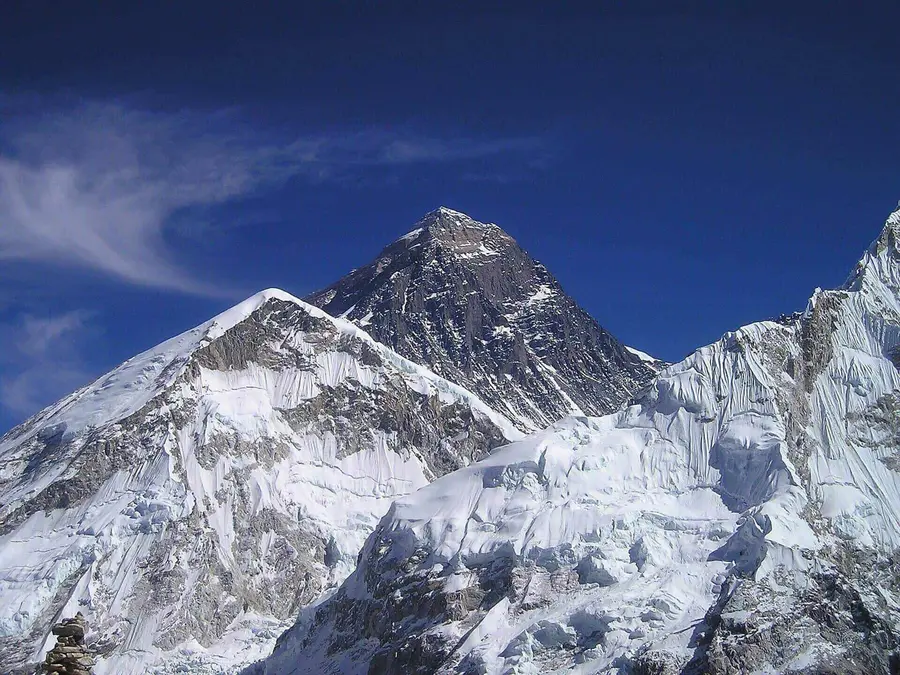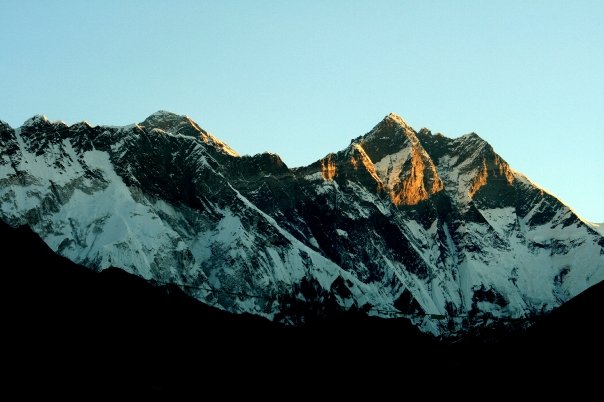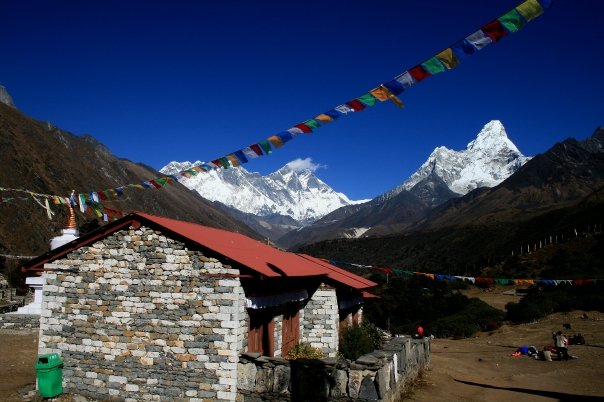Overview
The EBC trek combined with Island Peak is an extraordinary adventure that provides a one-of-a-kind and unforgettable trekking experience. This expedition combines two iconic Himalayan journeys into one unforgettable adventure. The EBC trek takes you through the heart of the Khumbu region, with views of the world’s highest peaks, including Mount Everest. You’ll be immersed in Sherpa culture along the way, visiting ancient monasteries and vibrant villages.
The ascent of Island Peak, a challenging but accessible 6,189-meter peak that provides a taste of mountaineering without the extreme technical difficulties of higher summits, is the highlight of this trek. The climb provides panoramic views of the Everest region, as well as a sense of accomplishment that few other trekking experiences can match. This combination allows you to not only witness the Himalayan majesty but also put your mountaineering skills to the test. It’s ideal for trekkers looking for a thrilling and diverse adventure in one of the world’s most beautiful mountain landscapes.
Note: Only Private Packages Available for this trek.
Trip Highlights
- Thrilling adventure to the base of the world’s highest peak
- Scenic view of the grand mountains from Kalapathar peak
- Conquering the difficult Kongma La Pass (5535m)
- Get to climb Island Peak (6189m); one of the most popular peaks to climb
- Experience the scenic flight from Kathmandu to Lukla
- Explore the beautiful Sherpa villages and get familiar with their Buddhist culture and customs
Itinerary
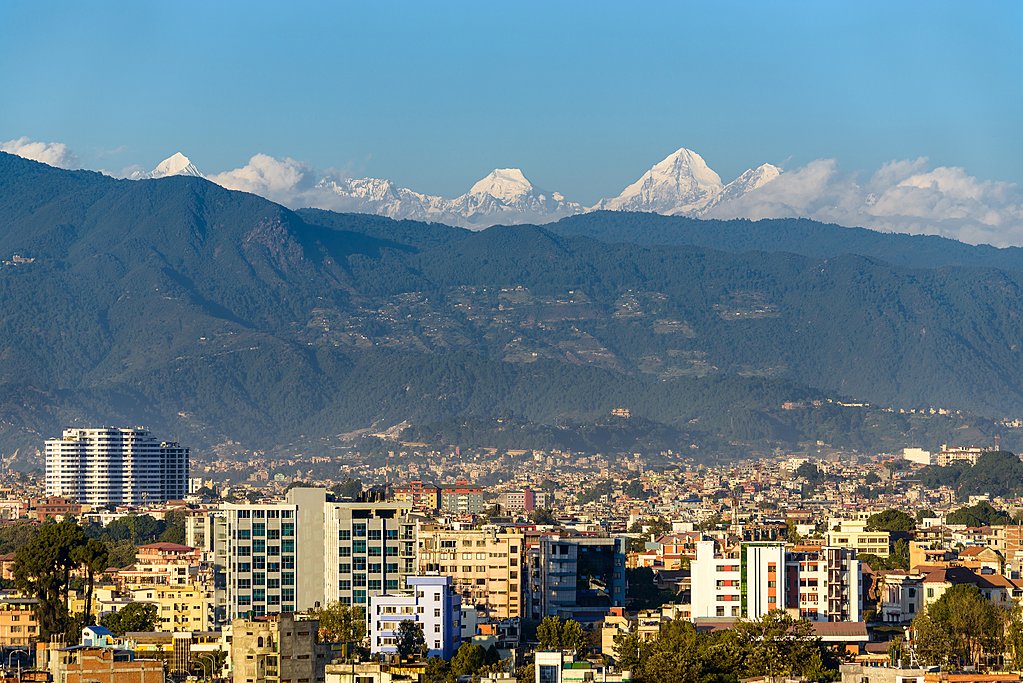 Kathmandu
Our representative will welcome you at Kathmandu Airport on your arrival day. Our representative will be standing outside the arrival gate with flash board of our company Adventure Speed Trek & there will be your name written in same board. It will be your First impressions of Kathmandu. On Arrival at Hotel we discuss about trip shortly.
Kathmandu
Our representative will welcome you at Kathmandu Airport on your arrival day. Our representative will be standing outside the arrival gate with flash board of our company Adventure Speed Trek & there will be your name written in same board. It will be your First impressions of Kathmandu. On Arrival at Hotel we discuss about trip shortly.
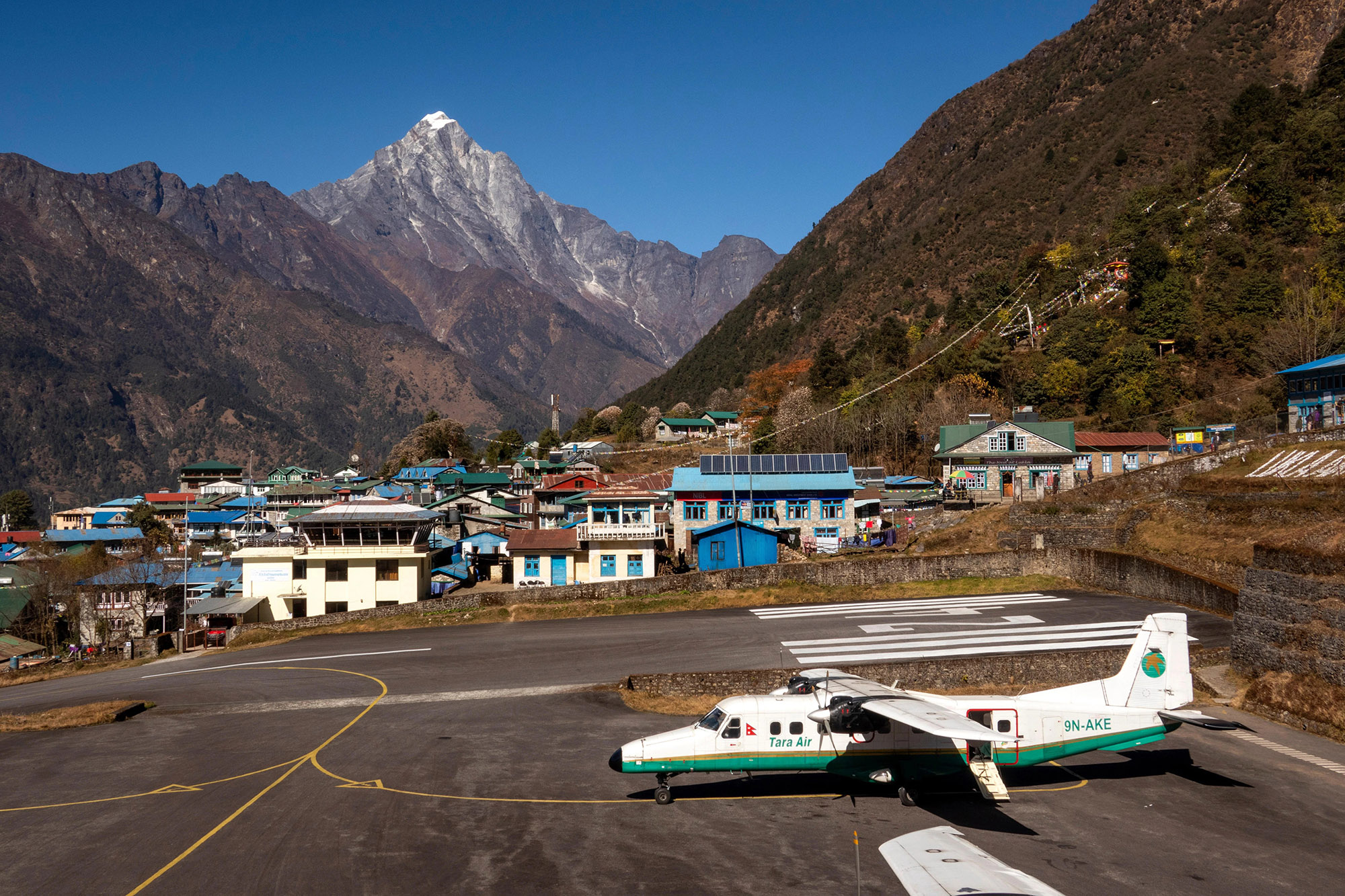 Lukla
Usually flight to Lukla is scheduled in morning time. You will be picked up from your hotel early morning then transfer to domestic Airport of Kathmandu. A short flight of 45 minutes will bring you to Pasanglyamu Airport at Lukla (2 850 m). Breakfast break is made in Lukla then we start trekking through beautiful settlements to join soon the main trail in Churi Kharka. We follow the east bank of the Dudh Koshi- the River of Milk- where you witness the typical Nepal terrace culture, slate roofed houses and views on Kusum Kangaru (5 579 m). We reach Phakding (2 640 m) after 3 - 4 h gentle walking.
Lukla
Usually flight to Lukla is scheduled in morning time. You will be picked up from your hotel early morning then transfer to domestic Airport of Kathmandu. A short flight of 45 minutes will bring you to Pasanglyamu Airport at Lukla (2 850 m). Breakfast break is made in Lukla then we start trekking through beautiful settlements to join soon the main trail in Churi Kharka. We follow the east bank of the Dudh Koshi- the River of Milk- where you witness the typical Nepal terrace culture, slate roofed houses and views on Kusum Kangaru (5 579 m). We reach Phakding (2 640 m) after 3 - 4 h gentle walking.
Overnight: Lodge(ABLD)
-
Highlights of the Day:
- Exciting flight to the world’s most extreme airport at Lukla
- Splendid view of the mountains and surrounding landscapes
- First day hiking to Sherpaland( Home of world famous Sherpa climbers)
 Namche Bazaar
After breakfast, you will hit the trail early and head towards Namche Bazaar. Upon leaving Phakding village, the trek continues on the bank of Dudh Koshi River. This part of the trail is largely under the shades of the pine forest, but also crosses several yak pastures and Sherpa villages, namely Benkar and Chumoa. Along the route, you will also cross a long, high steel suspension bridge — The Hillary Bridge — to enter the Sagarmatha National Park at Monjo.Once you enter the national park, the trail becomes very steep, going uphill towards Jorsalle village. However, after a while, the strenuous trail treats you to the marvelous view of Thamserku, Everest, Nuptse, and Kusum Kanguru.As you continue climbing the steep uphill, savoring the picturesque mountain backdrop, you’ll arrive at Namche Bazaar. Often regarded as the Gateway to the Himalayas, Namche Bazaar is surrounded by hotels, teahouses, restaurants, cafes, and colorful markets. From the village, you will have a close-up glimpse of Thamserku and Kongde-Ri.
Namche Bazaar
After breakfast, you will hit the trail early and head towards Namche Bazaar. Upon leaving Phakding village, the trek continues on the bank of Dudh Koshi River. This part of the trail is largely under the shades of the pine forest, but also crosses several yak pastures and Sherpa villages, namely Benkar and Chumoa. Along the route, you will also cross a long, high steel suspension bridge — The Hillary Bridge — to enter the Sagarmatha National Park at Monjo.Once you enter the national park, the trail becomes very steep, going uphill towards Jorsalle village. However, after a while, the strenuous trail treats you to the marvelous view of Thamserku, Everest, Nuptse, and Kusum Kanguru.As you continue climbing the steep uphill, savoring the picturesque mountain backdrop, you’ll arrive at Namche Bazaar. Often regarded as the Gateway to the Himalayas, Namche Bazaar is surrounded by hotels, teahouses, restaurants, cafes, and colorful markets. From the village, you will have a close-up glimpse of Thamserku and Kongde-Ri.
Overnight: Guesthouse
Meals: breakfast, Lunch and Dinner
-
High Lights of the Day:
- Cross over the thrilling suspension bridges
- Trekking through Sagarmatha National Park
- View Kusum Kanguru, Thamserku, Mt.Everest, and Nuptse
- Walk along the bustling streets of Namche Bazaar
- Exploration of world Highest Tourism city Namche
 Everest View Hotel
The trek will take you above 4,000 meters over the next few days, so this time is especially important for your body to adjust to the altitude in addition to reducing the risk of altitude sickness.
While it is a rest day, you may take a short hike to the hills above Namche Bazaar, toward the settlement of Syangboche. Here, you will visit the Everest View Hotel — one of the world’s highest luxury hotels.
From the hotel’s sundeck, you can savor panoramic views of Ama Dablam, Thamserku, Mount Everest, Nuptse, Kwange, Kangtega, Lhotse, Taboche, and Khumbila.
On your way back to Namche Bazaar, there will be an opportunity to enjoy the Everest Photo Gallery and Sherpa Culture Museum.
Everest View Hotel
The trek will take you above 4,000 meters over the next few days, so this time is especially important for your body to adjust to the altitude in addition to reducing the risk of altitude sickness.
While it is a rest day, you may take a short hike to the hills above Namche Bazaar, toward the settlement of Syangboche. Here, you will visit the Everest View Hotel — one of the world’s highest luxury hotels.
From the hotel’s sundeck, you can savor panoramic views of Ama Dablam, Thamserku, Mount Everest, Nuptse, Kwange, Kangtega, Lhotse, Taboche, and Khumbila.
On your way back to Namche Bazaar, there will be an opportunity to enjoy the Everest Photo Gallery and Sherpa Culture Museum.
Overnight: Guesthouse
Meals: breakfast, Lunch and Dinner
-
Highlights of The day
- Day hike to Khumjung village one of the largest Sherpa habitation
- Visit Edmund Hilary school and Historical Buddhist monastery
- Visit Everest View Hotel, the world’s highest hotel
- Marvel at the sensational glimpses of the Himalayas
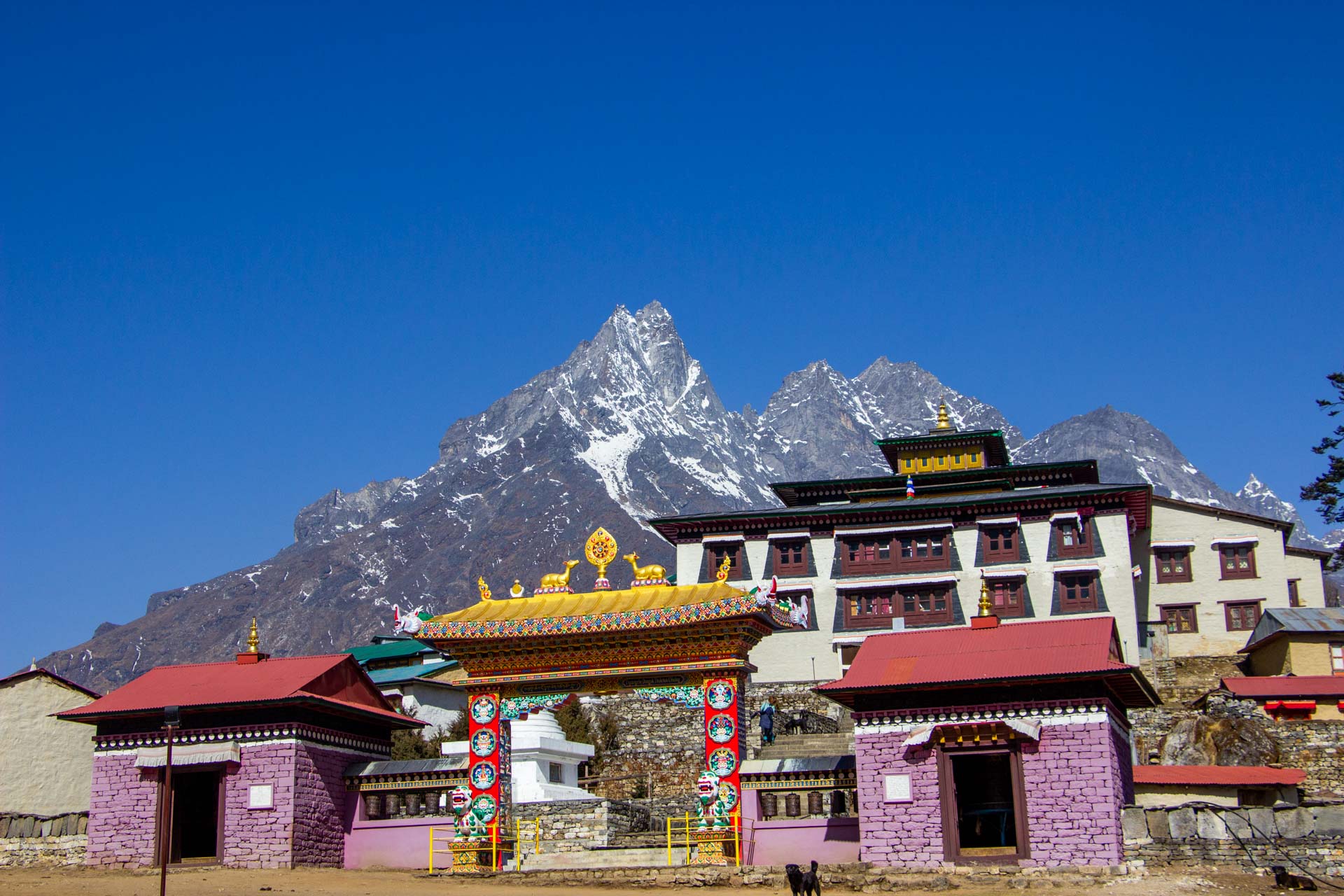 Tengboche
After the acclimatization day at Namche Bazaar, the adventure continues on a pleasant path. At this point, the trail passes through dense rhododendron forest and occasional Sherpa villages.
With marvelous mountain views in the background, this part of the trail is often regarded as the most scenic portion of the Everest Base Camp Trek. As you continue the gradual walk along the hillside above the Dudh Koshi River, you’ll arrive at Phungithanga.Once you pass through Phungithanga, the pleasant route transforms into a more strenuous uphill walk. You will cross the Imja Khola — a tributary of the Dudh Koshi River — under the shades of rhododendron forest, and then arrive in Tengboche.Tengboche is a small Sherpa settlement scattered right below a crescent-shaped ridge. It is well-known for being the home of Khumbu’s largest Buddhist monastery — Tengboche Monastery. The sight from the front yard of the monastery is sublime.You can enjoy the close-up view of Ama Dablam along with surrounding mountains, including Everest, Nuptse, and Lhotse.
Tengboche
After the acclimatization day at Namche Bazaar, the adventure continues on a pleasant path. At this point, the trail passes through dense rhododendron forest and occasional Sherpa villages.
With marvelous mountain views in the background, this part of the trail is often regarded as the most scenic portion of the Everest Base Camp Trek. As you continue the gradual walk along the hillside above the Dudh Koshi River, you’ll arrive at Phungithanga.Once you pass through Phungithanga, the pleasant route transforms into a more strenuous uphill walk. You will cross the Imja Khola — a tributary of the Dudh Koshi River — under the shades of rhododendron forest, and then arrive in Tengboche.Tengboche is a small Sherpa settlement scattered right below a crescent-shaped ridge. It is well-known for being the home of Khumbu’s largest Buddhist monastery — Tengboche Monastery. The sight from the front yard of the monastery is sublime.You can enjoy the close-up view of Ama Dablam along with surrounding mountains, including Everest, Nuptse, and Lhotse.
Overnight: Guesthouse
Meals: breakfast, Lunch and Dinner
-
Highlights of the day:
- Visit the ancient Tengboche Monastery — the largest in Khumbu.
- Magnificent view of Ama Dablam, Everest, Nuptse, Lhotse, and others mountains
 Dingboche
We recommend that you wake up early on this day to watch the sunrise over Ama Dablam as it is extraordinary, and you will surely not regret your decision.The day walking begins after breakfast and you will move north from Tengboche village. After crossing a suspension bridge over the Imja Khola, the trail continues beside the hamlet of Pangboche village. From here on, the route becomes much more narrow.The next village is Orsho, and you will take the lower route towards the bank of Imja Khola. There are many mani walls, prayer flags, and chortens just before you arrive in Dingboche.Situated at 4,410 meters above sea level, Dingboche marks one of Khumbu’s highest Sherpa settlements. Hence, most trekkers begin to feel the effects of the high altitude at this point of the trek. Be sure to keep your body warm and stay hydrated to reduce the risk of falling ill.
Dingboche
We recommend that you wake up early on this day to watch the sunrise over Ama Dablam as it is extraordinary, and you will surely not regret your decision.The day walking begins after breakfast and you will move north from Tengboche village. After crossing a suspension bridge over the Imja Khola, the trail continues beside the hamlet of Pangboche village. From here on, the route becomes much more narrow.The next village is Orsho, and you will take the lower route towards the bank of Imja Khola. There are many mani walls, prayer flags, and chortens just before you arrive in Dingboche.Situated at 4,410 meters above sea level, Dingboche marks one of Khumbu’s highest Sherpa settlements. Hence, most trekkers begin to feel the effects of the high altitude at this point of the trek. Be sure to keep your body warm and stay hydrated to reduce the risk of falling ill.
Overnight: Guesthouse
Meals: breakfast, Lunch and Dinner
-
Highlights of the day:
- Cross the thrilling suspension bridge over Dudh Koshi River
- Walk past well-decorated mani walls and chortens
- Close-up view of Ama Dablam — the most beautiful mountain in the world
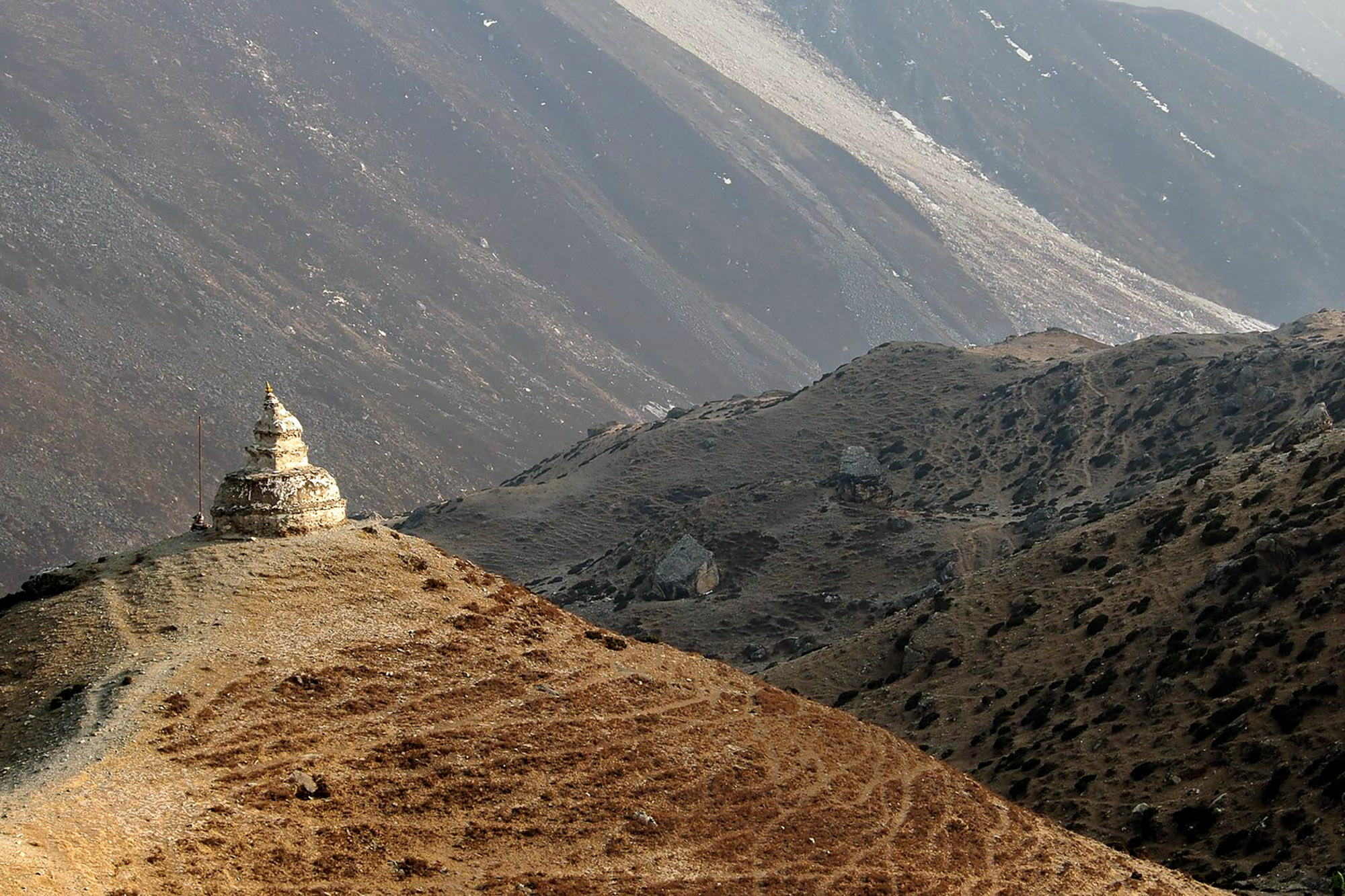 Dingboche
Due to the altitude, there is another rest and acclimatization day to help your body adjust. However, you will still take a short hike to a nearby hill to keep feeling active and ready for the remainder of the trek.While it is a steep ascent from Dingboche to the summit of Nagarjun Hill (located at 5,100 meters), the peak offers beautiful views of Ama Dablam, Lobuche, Lhotse, Nuptse, Cholatse, and Kangtega.After a brief break at the summit, you’ll descend back to Dingboche to get some rest. If you are feeling healthy and wanting further activities, you may choose to explore the village on another short tour.
Dingboche
Due to the altitude, there is another rest and acclimatization day to help your body adjust. However, you will still take a short hike to a nearby hill to keep feeling active and ready for the remainder of the trek.While it is a steep ascent from Dingboche to the summit of Nagarjun Hill (located at 5,100 meters), the peak offers beautiful views of Ama Dablam, Lobuche, Lhotse, Nuptse, Cholatse, and Kangtega.After a brief break at the summit, you’ll descend back to Dingboche to get some rest. If you are feeling healthy and wanting further activities, you may choose to explore the village on another short tour.
Overnight: Guesthouse
Meals: breakfast, Lunch and Dinner
-
Highlights of the day:
- Hike to Nangkartshang Peak
- Enjoy the superb view of Ama Dablam, Makalu, Lhotse, Kantega, and Cho Oyu
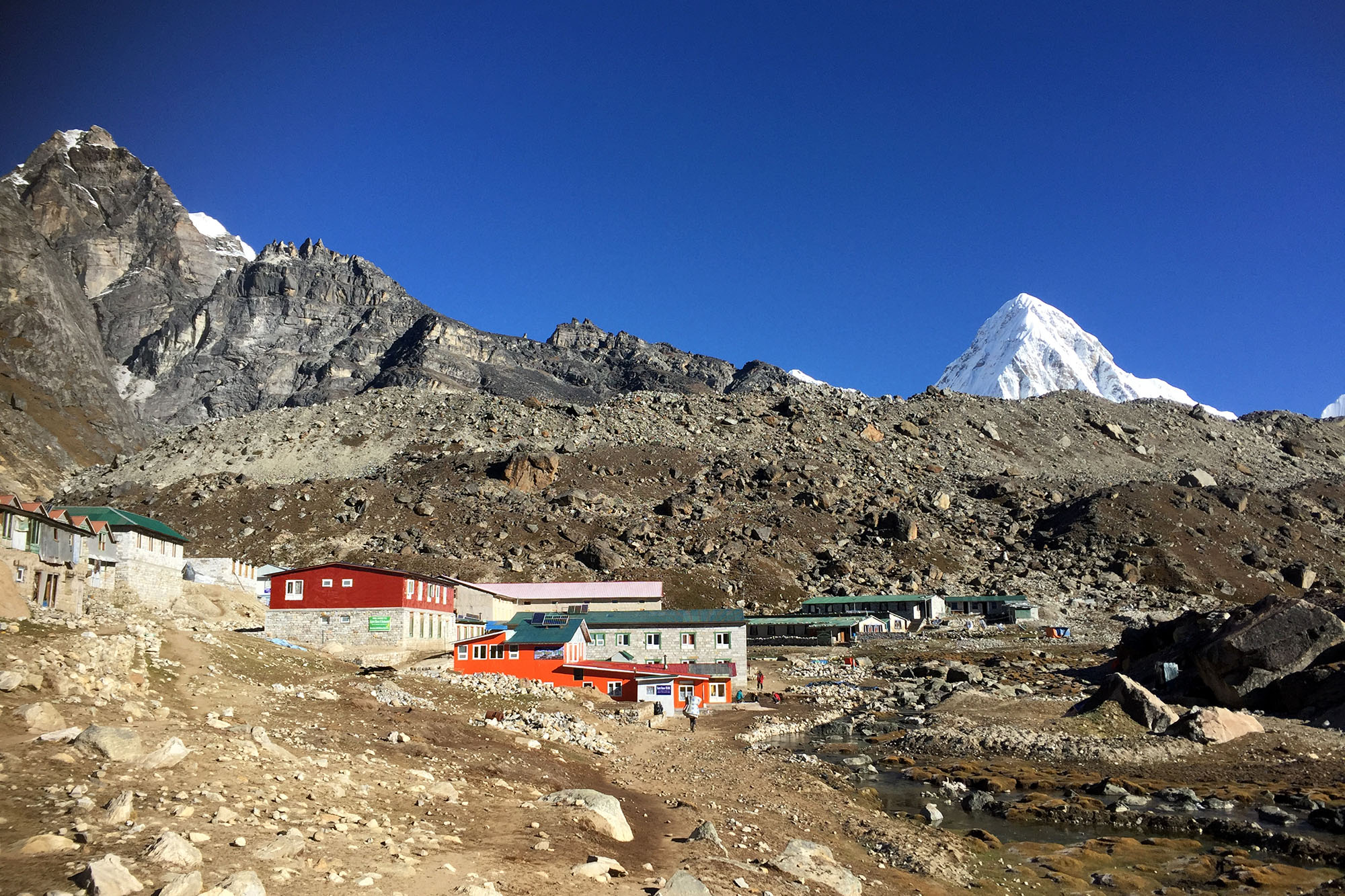 Lobuche
This day begins with a gradual ascend towards Thukla, here, the scenery changes and becomes much barer and more desolate, with only alpine scrubs surrounding the trail.
After some time, the trail becomes somewhat strenuous, with a steep uphill over the moraine of Khumbu Glacier. Upon climbing the steep ridge, you will arrive at the summit of Thukla Pass. Here there is an area where you will see many stone shrines dedicated to fallen climbers.
Following this pass, you will walk through grassy valleys and rocky terrain to arrive at Lobuche. This village consists only of teahouses, with no permanent settlements here. It lies in a narrow meadow sandwiched between Lobuche Peak and Khumbu Glacier. You will be able to enjoy the incredible sight of Taboche and Nuptse soaring above the teahouse.In the evening, you may choose to take a short hike to the narrow gap of the moraine and the mountain wall to see the Khumbu Glacier.
Lobuche
This day begins with a gradual ascend towards Thukla, here, the scenery changes and becomes much barer and more desolate, with only alpine scrubs surrounding the trail.
After some time, the trail becomes somewhat strenuous, with a steep uphill over the moraine of Khumbu Glacier. Upon climbing the steep ridge, you will arrive at the summit of Thukla Pass. Here there is an area where you will see many stone shrines dedicated to fallen climbers.
Following this pass, you will walk through grassy valleys and rocky terrain to arrive at Lobuche. This village consists only of teahouses, with no permanent settlements here. It lies in a narrow meadow sandwiched between Lobuche Peak and Khumbu Glacier. You will be able to enjoy the incredible sight of Taboche and Nuptse soaring above the teahouse.In the evening, you may choose to take a short hike to the narrow gap of the moraine and the mountain wall to see the Khumbu Glacier.
Overnight: Guesthouse
Meals: breakfast, Lunch and Dinner
-
Highlights of the day:
- Breathtaking view of Ama Dablam, Taboche, and Cholatse
- Close-up view of Nuptse and Taboche
- Look over the marvelous Khumbu Glacier.
 Everest Base Camp
After having breakfast in Lobuche, you will begin walking on a rough and rocky trail towards Gorak Shep. However, despite the rough trail, you will be able to enjoy views of Nuptse, Pumori, and other mountains.It takes a few hours on this challenging trail before you will arrive in Gorak Shep. You will have a little time to rest and leave your backpack before getting back to walking towards Everest Base Camp. Along the way, you will see several small streams and glacial moraines and will be walking alongside the Khumbu Glacier.The Khumbu Glacier is similar to a lunar landscape with gray boulders, ice formations, and small craters. It will take about two hours before you will be standing at the foothills of the world’s highest mountain — Mount Everest.Upon reaching Everest Base Camp, you can celebrate your achievement with your trekking guide and team members.From Everest Base Camp, you will have a marvelous sight of Khumbu Icefall, Khumbu Glacier, Nuptse, Pumori, Khumbutse, and a little bit of Everest.
After celebrating, and enjoying the well-deserved view, you will head back to the barren terrain of Gorak Shep for an overnight stay.
Everest Base Camp
After having breakfast in Lobuche, you will begin walking on a rough and rocky trail towards Gorak Shep. However, despite the rough trail, you will be able to enjoy views of Nuptse, Pumori, and other mountains.It takes a few hours on this challenging trail before you will arrive in Gorak Shep. You will have a little time to rest and leave your backpack before getting back to walking towards Everest Base Camp. Along the way, you will see several small streams and glacial moraines and will be walking alongside the Khumbu Glacier.The Khumbu Glacier is similar to a lunar landscape with gray boulders, ice formations, and small craters. It will take about two hours before you will be standing at the foothills of the world’s highest mountain — Mount Everest.Upon reaching Everest Base Camp, you can celebrate your achievement with your trekking guide and team members.From Everest Base Camp, you will have a marvelous sight of Khumbu Icefall, Khumbu Glacier, Nuptse, Pumori, Khumbutse, and a little bit of Everest.
After celebrating, and enjoying the well-deserved view, you will head back to the barren terrain of Gorak Shep for an overnight stay.
- Excursion to the Everest Base Camp
- Opportunity to stand at the shore of the world’s highest mountain
- Enjoy the close-up view of Nuptse, Pumori, Khumbu Icefall, and Khumbutse.
 Kalapatthar
The day starts before sunrise to hike up to the landmark of Kala Patthar. While the trail is not long, it is steep, rocky, and very challenging.Located at 5,545 meters, Kala Patthar is the highest elevation of this trek. From the summit, you will be able to enjoy the sunrise over the Himalayas, with a 360-degree view of the highest peaks in the world including Mt. Everest, Nuptse, Lhotse, and Ama Dablam, Thamserku, Pumori, and more.
After taking in the sunrise, you will retrace your steps, back to Gorak Shep for breakfast, before descending towards Pheriche. You will walk along the rugged trail and pass through Lobuche.
Kalapatthar
The day starts before sunrise to hike up to the landmark of Kala Patthar. While the trail is not long, it is steep, rocky, and very challenging.Located at 5,545 meters, Kala Patthar is the highest elevation of this trek. From the summit, you will be able to enjoy the sunrise over the Himalayas, with a 360-degree view of the highest peaks in the world including Mt. Everest, Nuptse, Lhotse, and Ama Dablam, Thamserku, Pumori, and more.
After taking in the sunrise, you will retrace your steps, back to Gorak Shep for breakfast, before descending towards Pheriche. You will walk along the rugged trail and pass through Lobuche.
 Chhukung
After breakfast, we trek via Khumbu Glacier to Kongma La Base Camp (5,000 m/16,404 ft). The ascent to Kongma La pass is the most difficult part of our trek today. In the Kongma La, we see cairns wrapped in prayer flags to mark the pass. Then we descend gradually to Imja Khola valley, followed by another descent to Chhukung, a small summer settlement. After reaching Chhukung we will also check our equipment in order to get ready for our ultimate climb.
Chhukung
After breakfast, we trek via Khumbu Glacier to Kongma La Base Camp (5,000 m/16,404 ft). The ascent to Kongma La pass is the most difficult part of our trek today. In the Kongma La, we see cairns wrapped in prayer flags to mark the pass. Then we descend gradually to Imja Khola valley, followed by another descent to Chhukung, a small summer settlement. After reaching Chhukung we will also check our equipment in order to get ready for our ultimate climb.
Overnight: Chhukung
Meals: breakfast, Lunch and Dinner
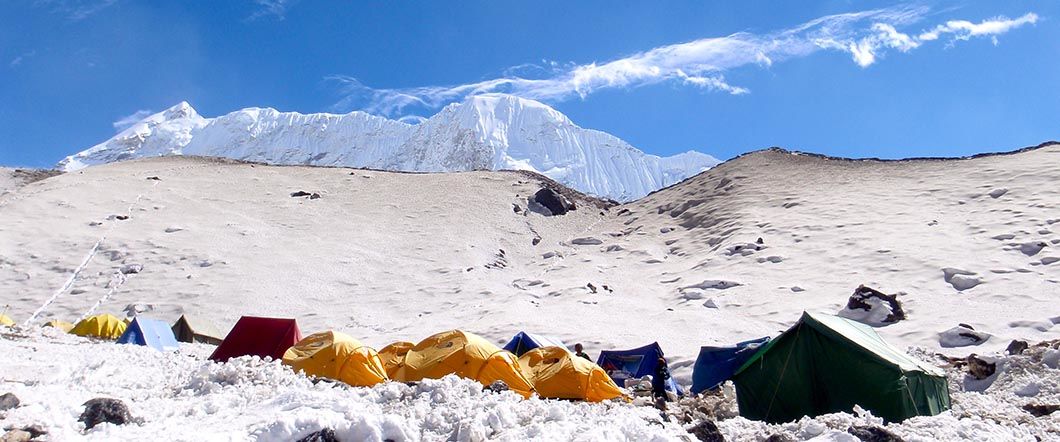 Island Peak base Camp
The trek to Island Peak Base Camp is on a fairly steep trail. First, we climb south then turn east to the main line of the valley. We then walk on a winding path below the southern flank of the moraine from the Lhotse Glacier. Next, we continue walking on a pleasant trail along a streamside. The route to the Amphu Lapcha lies to the southeast. A crisscross route through the Imja and Lhotse glacier moraines leads to a wide valley flanking the SW side of Island Peak.
Island Peak base Camp
The trek to Island Peak Base Camp is on a fairly steep trail. First, we climb south then turn east to the main line of the valley. We then walk on a winding path below the southern flank of the moraine from the Lhotse Glacier. Next, we continue walking on a pleasant trail along a streamside. The route to the Amphu Lapcha lies to the southeast. A crisscross route through the Imja and Lhotse glacier moraines leads to a wide valley flanking the SW side of Island Peak.
Overnight: Island Peak Base Camp
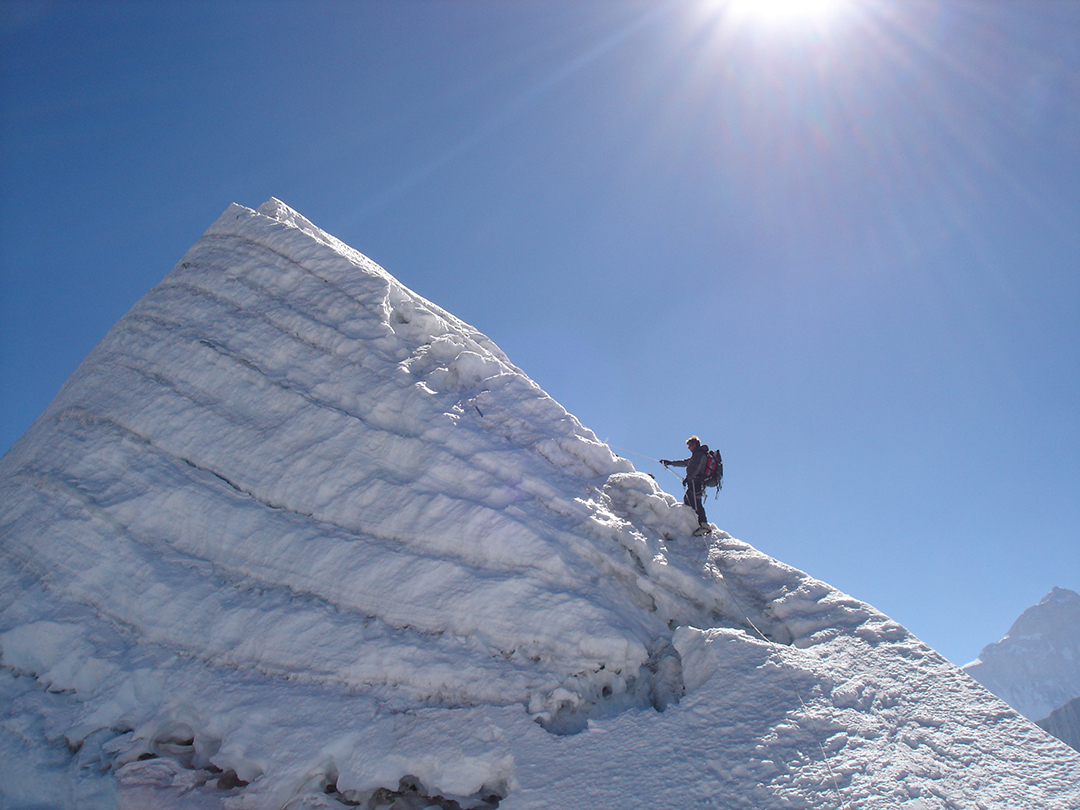 Island Peak Summit
We wake up early today at around 12 to 1 am and have our breakfast before beginning our climb. It is important we reach the summit before noon because in the afternoon the strong winds in the highlands might become a barrier for a successful summit. The trail moves up beyond the base camp for several hundred meters before striking off the steep hillside. Initially sandy, the path soon turns to grass before becoming boulder strewn. As we climb up the hill, we will see that the slope narrows and the trail enters a steep rock channel. We climb the rock gully. This is not difficult, but there are several short rock steps to climb before we emerge on the right side of the gully. The route then follows a ridgeline, which leads to an exhilarating and exposed traverse onto the snout of the summit glacier. The guides will fix a rope when required. A steep snow slope leads us onto the summit ridge. Both fixed rope and man rope will be used during the climb for safety. We use fixed rope after successfully climbing on rock. The length of the rope will usually be 350 m. However, the length depends on the time of the season and the crevasses.There are two newly formed crevasses which are approximately 3 and 4 meters long. We will be using ladders to cross them. After enjoying the summit views and taking pictures, we descend all the way to Island Peak Base Camp where some of our crew are waiting for us. We celebrate on our successful Island Peak climb.
Hiking: 10-12 hrs
Island Peak Summit
We wake up early today at around 12 to 1 am and have our breakfast before beginning our climb. It is important we reach the summit before noon because in the afternoon the strong winds in the highlands might become a barrier for a successful summit. The trail moves up beyond the base camp for several hundred meters before striking off the steep hillside. Initially sandy, the path soon turns to grass before becoming boulder strewn. As we climb up the hill, we will see that the slope narrows and the trail enters a steep rock channel. We climb the rock gully. This is not difficult, but there are several short rock steps to climb before we emerge on the right side of the gully. The route then follows a ridgeline, which leads to an exhilarating and exposed traverse onto the snout of the summit glacier. The guides will fix a rope when required. A steep snow slope leads us onto the summit ridge. Both fixed rope and man rope will be used during the climb for safety. We use fixed rope after successfully climbing on rock. The length of the rope will usually be 350 m. However, the length depends on the time of the season and the crevasses.There are two newly formed crevasses which are approximately 3 and 4 meters long. We will be using ladders to cross them. After enjoying the summit views and taking pictures, we descend all the way to Island Peak Base Camp where some of our crew are waiting for us. We celebrate on our successful Island Peak climb.
Hiking: 10-12 hrs
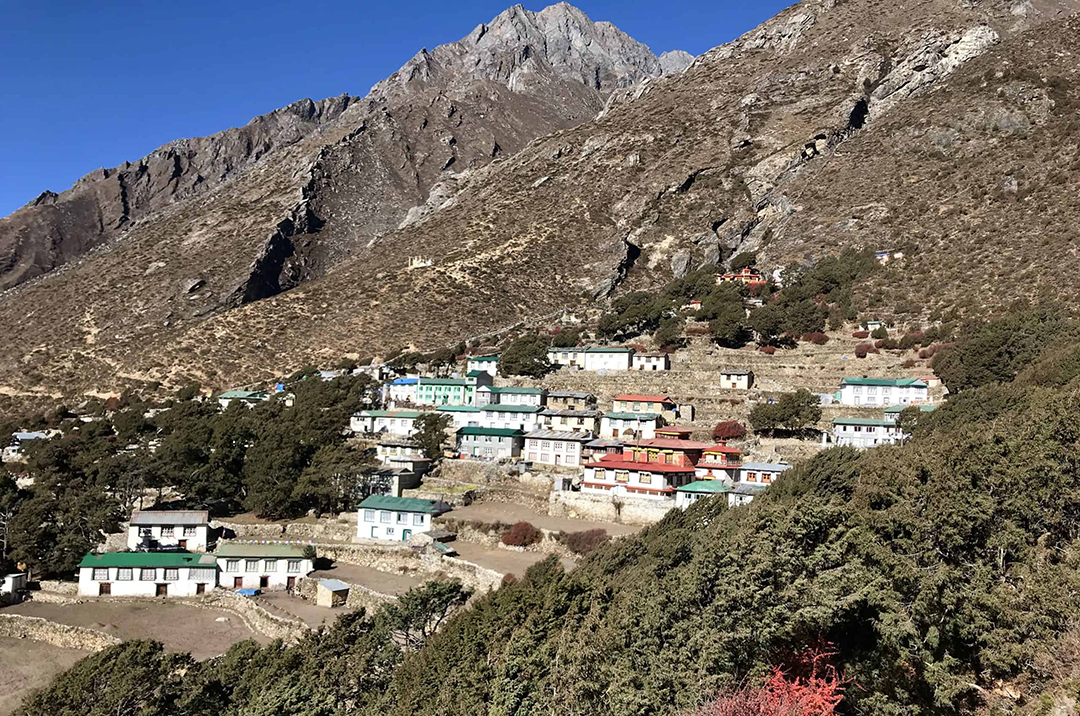 Pangboche
Today’s walk will be a much easier as we descend to the lower altitudes. Following the same route back through the wide valley of Khumbu Khola, we pass through the beautiful Sherpa villages Orsho and Shomare. We can also take a different trail to visit the Gompa in Upper Pangboche, which is believed to be the oldest in the Khumbu region or take the regular trail to reach Pangboche. Pangboche is a scenic village surrounded by Everest to its north, Ama Dablam, Thamserku, and Kangtaiga to the east, the Kongde range to the south and the Imja Tse river flowing through the wide fertile valley.
Hiking: 5-6 hrs
Pangboche
Today’s walk will be a much easier as we descend to the lower altitudes. Following the same route back through the wide valley of Khumbu Khola, we pass through the beautiful Sherpa villages Orsho and Shomare. We can also take a different trail to visit the Gompa in Upper Pangboche, which is believed to be the oldest in the Khumbu region or take the regular trail to reach Pangboche. Pangboche is a scenic village surrounded by Everest to its north, Ama Dablam, Thamserku, and Kangtaiga to the east, the Kongde range to the south and the Imja Tse river flowing through the wide fertile valley.
Hiking: 5-6 hrs
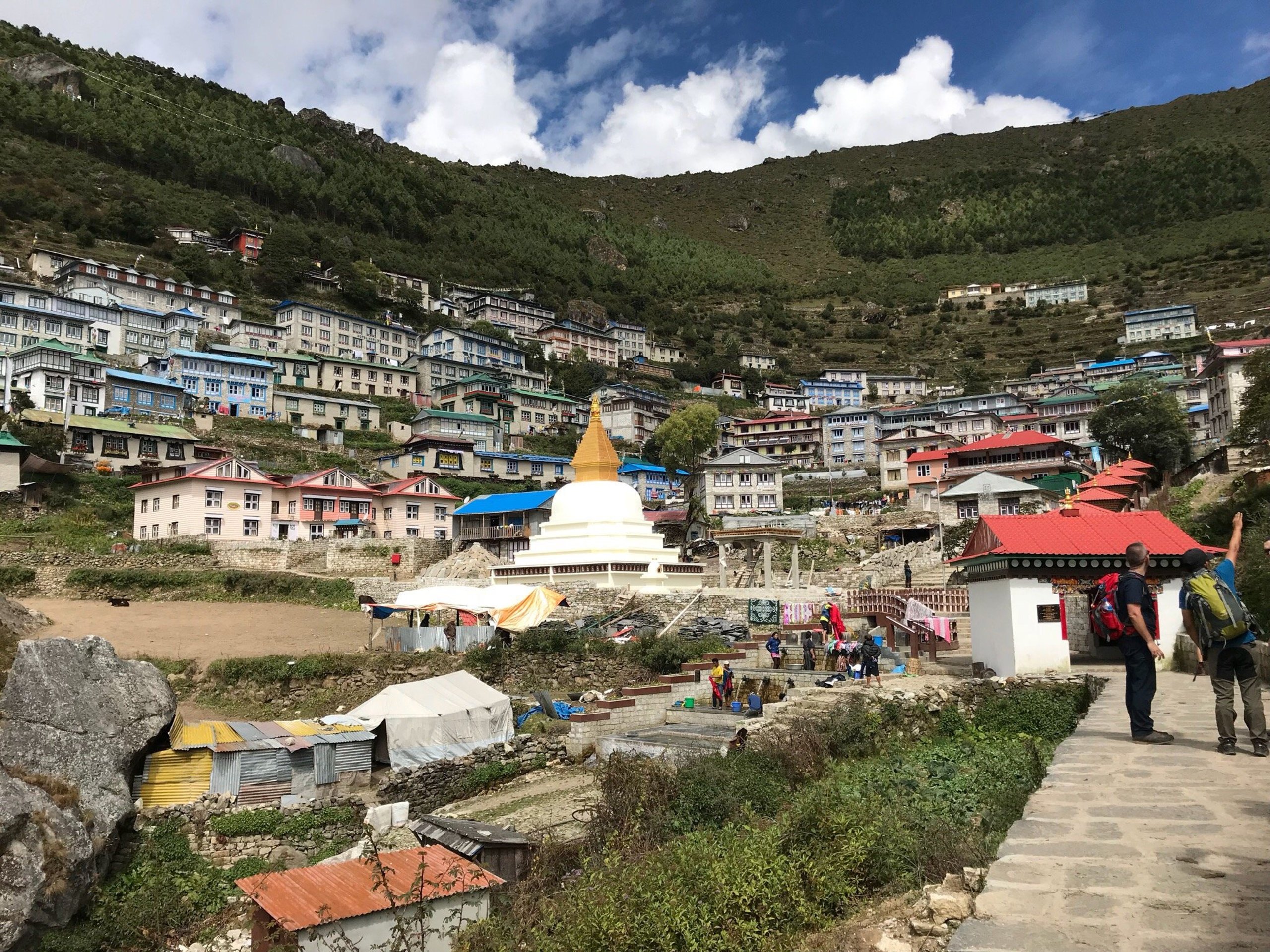 Namche Bazaar
From Pangboche we retrace our steps down to the Imja Khola and up through the forest to Tengboche. If interested, we can also visit nuns at the Tengboche monastery. After lunch at Tengboche, we continue through the hillside blanketed by rhododendron and juniper trees. After crossing the bridge over the Dudh Koshi River, our trail follows the Dudh Koshi gorge descending rapidly through the pine forests before reaching Sansa. We keep a lookout for wildlife such as mountain goats, snow leopards, colorful pheasants, etc., while passing through the forest. After passing a chorten, we reach the army camp at Namche Bazaar.
Hiking: 4-5 hrs
Namche Bazaar
From Pangboche we retrace our steps down to the Imja Khola and up through the forest to Tengboche. If interested, we can also visit nuns at the Tengboche monastery. After lunch at Tengboche, we continue through the hillside blanketed by rhododendron and juniper trees. After crossing the bridge over the Dudh Koshi River, our trail follows the Dudh Koshi gorge descending rapidly through the pine forests before reaching Sansa. We keep a lookout for wildlife such as mountain goats, snow leopards, colorful pheasants, etc., while passing through the forest. After passing a chorten, we reach the army camp at Namche Bazaar.
Hiking: 4-5 hrs
Overnight: Nmache Bazaar
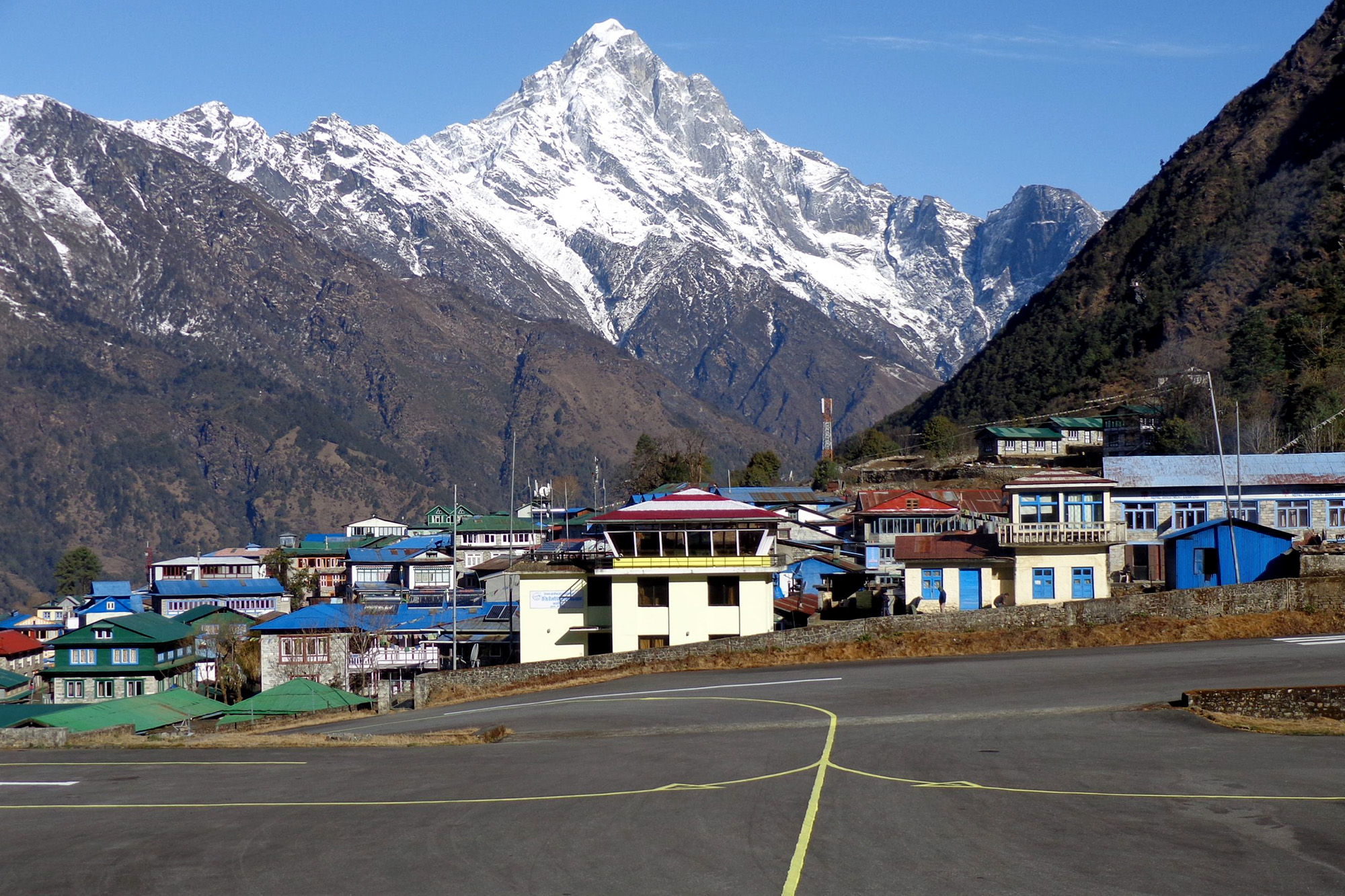 Lukla
The trail descends steeply downward so we need to walk cautiously as our shaky legs continuously battle the rocky terrain. After crossing the suspension bridges over the fast flowing Dudh Koshi and its tributaries, the trail becomes more level and natural. After our arrival in Lukla, we stretch those sore legs and recall the experiences of the last couple of weeks.
Lukla
The trail descends steeply downward so we need to walk cautiously as our shaky legs continuously battle the rocky terrain. After crossing the suspension bridges over the fast flowing Dudh Koshi and its tributaries, the trail becomes more level and natural. After our arrival in Lukla, we stretch those sore legs and recall the experiences of the last couple of weeks.
Overnight: Lukla
Meals: breakfast, Lunch and Dinner
-
Highlights of the Day
- Cross several suspension bridges over raging Dudh Koshi River
- Walk past the pleasant forest trail surrounded by rhododendron and pine trees.
- Celebrate the success with your trekking guide and all the dedicated staffs in the evening
 Kathmandu
This is the final day of your trek and early in the morning, while the weather is good, you will board a flight back to Kathmandu. Be sure to enjoy one last view of the incredible region as you fly to the city.After the short 30-minute flight, you will arrive in Kathmandu and then be transferred to the hotel. You are then free to rest or wander around Thamel to purchase souvenirs for your friends and family back home.There are also plenty of restaurants to choose from in this part of the city, serving everything from local to international cuisines. After your time in the mountains, you will be sure to find something to enjoy for dinner. On arrival in Kathmandu trip will be over. If you have extra days we can discuss about other tours and activities.
Kathmandu
This is the final day of your trek and early in the morning, while the weather is good, you will board a flight back to Kathmandu. Be sure to enjoy one last view of the incredible region as you fly to the city.After the short 30-minute flight, you will arrive in Kathmandu and then be transferred to the hotel. You are then free to rest or wander around Thamel to purchase souvenirs for your friends and family back home.There are also plenty of restaurants to choose from in this part of the city, serving everything from local to international cuisines. After your time in the mountains, you will be sure to find something to enjoy for dinner. On arrival in Kathmandu trip will be over. If you have extra days we can discuss about other tours and activities.
-
Highlights of the day:
- Incredible flight from Lukla to Kathmandu
- Enjoy the breathtaking sight of the mountains and surrounding landscapes.
- Farewell dinner in the evening
Services
Services Included in the Package
- Accommodation in guest house/Lodge During Trekking
- Max Three Nights Tented Accommodation during climbing period
- Breakfast during Trekking
- Full Board Meal during climbing Period
- A trekking /Climbing guide
- Peak Climbing Permit
- Peak Climbing Equipment for guide
- Trekking porter shared between two members
- Sagarmatha National Park fee
- TIMS trekking permit/Peak permit
- Insurance & equipment for guide & porter
- Accommodation, meals & daily allowance of
- trekking staff
- Round trip flights (Kathmandu-Lukla-Kathmandu)
- Round trip flight to/from Lukla for Guide
- Pick up/drop off to/from Domestic Airport
Services Excluded in the Package
- All drinks (Hot/cold/bottled) during trek
- Lunch & Dinner Except climbing period
- Recharging cost of electronic devices during trek
- Hot shower cost
- Personal climbing gears
- Travel/Medical Insurance
- Emergency Evacuation cost if necessary
More Info
Risk and Liability:
We will endeavor to make your program smooth and as pleasant as possible. However, the entire course of trekking depends on the ranges of the mighty mountains, physical health, and environmental conditions. Therefore, Adventure Speed ( P) ltd shall not be responsible for any changes in the itineraries due to unavoidable circumstances and natural disasters such as landslide, road blockage, flood, snowing, cancellation of flight and delay, any types of sickness including altitude sickness.
What to Expect:
The Everest Base Camp trek is a challenging trek that requires prior trekking/hiking experience. During the course, we will trek average 6 hours per day on moderate to steep grades, at varied elevations. Some days will be rest days with optional hikes to properly acclimatize, while on other days you will continue your journey towards EBC. Your Trek guide will set a suitable pace to minimize the risk of altitude issues. Porters will transport your gear. Please tell us in prior if you are under medication or under the supervision of doctors.
Alternative routes in this Area
Everest Area trekking offers several routes. One can trek one weeks to multiple weeks in Everest region. Everest Base camp trek, Gokyo lake/Gokyo Ri trek, Everest Base camp trek and Gokyo Lake via Chola, Everest Three Passes are some popular routes. You can combine the trip with peak climbing as well. So we can also customize the trip according to your time availability, budge and interest.
Guide & Permit
Our guides are trained and expected. We provide Sherpa guide from Everest Area for Everest trekking. He is more familiar with geography, culture and people. Our staffs are insured, well equipped and well paid. For Everest TIMS (Trekkers Information Management System) and National park permits are required. You also need peak climbing permit which is applied through registered trekking agency like “Adventure Speed.
Accommodation and Food
Generally we stay in Trekkers lodges /guests house that has twin bed room with shared bath/toilet. Sometime room with private bath also available. In Some places, luxurious resort and hotel are available. If you want to experience Himalayan luxury stay you can pay additional and stay.
Regarding the food we recommend your local foods that is healthier and cook perfectly.
Physical Fitness:
- Adequate cardiovascular fitness and stamina are essential. Engage in regular aerobic exercises such as running, hiking, or cycling to build endurance.
- Strength training for your legs, core, and upper body to carry heavy packs and navigate technical sections.
Altitude Acclimatization:
- Acclimate properly by spending time at progressively higher altitudes to minimize the risk of altitude sickness.
Technical Skills:
- Familiarize yourself with basic mountaineering techniques, including ice and snow travel, glacier crossing, and rope work.
- Seek guidance from experienced mountaineers or hire a local guide.
Equipment and Gear:
Technical Climbing gear
-
Harness
The harness is a strap worn around the waist with loops to fit your thighs for securing you to a rope or anchor. It must be well fitted and comfortable to wear. It is essential while climbing rocks and mountains. Thus, please kindly include it for Mera Peak.
-
Carabiners
The carabiner is a special type of shackle that is used to connect components, usually to protect your harness. They are used in rope-intensive activities. It is a good idea to bring six carabiners, three lockings, and three unlockings.
-
Crampons
Crampons are a grip device that is attached to the footwear to improve mobility on snow and ice during mountain/ice climbing. It improves your mobility while walking over snow and ice.
-
Climbing boot
Successful Mera Peak,depends on the comfortability and safety of your feet. A better pair of climbing boots is essential for your successful climbing. They are not completely stiff like ski boots as they need some degree of flexibility for climbing. Properly insulated boots with additional stiffness and support are to be arranged. Similarly, you need to be sure that they are compatible with the crampons.
-
Descender
Descender is a shape of 8 devices that are made up of Aluminium. These 8 figure locks allow you to have very precise control over speed while descending. This is like a friction brake used in combination with a climbing harness and carabiner.
-
Ascender
Ascender is a mechanical device that is attached to the rope to make ascending easy. It is used to provide safety and additional support to ascending. Therefore, it must be comfortable to use with gloves or mittens.
-
Trekking poles
Who can imagine walking on ice without trekking poles? Trekking poles help you to walk on rough terrain maintaining rhythm while walking on ice.
-
Ice-axes
Ice-axes is a straight and shafted ax with a gently curved pick used for both ascending and descending in ice surfaces. It is a multi-purpose hiking and climbing tool which you can use for digging, cutting steps, securing a harness or you can also simply use it as a walking stick.
-
Altimeter
The altimeter is the instrument used to measure the altitude of the place by measuring the atmospheric pressure.
-
Climbing helmet
Not many trekkers wear the helmet while doing the trek but it is an essential part of your gear for your own safety. It protects you from rock falls which are more serious than fall on the ground.
-
Climbing Ropes
Climbing rope is very necessary as it is used in various activities like climbing, making knots, abseiling, etc. Therefore, you must not forget to carry a climbing rope.
Clothing
When it comes to clothing, proper quality with comfortability is most important to complete your Mera Peak So, you must be serious about it. Use clothes that are quick-drying and light fabric and avoid cotton. Merino wool is famous because it is soft and has breath-ability while providing excellent insulation with the ability to absorb water very well and takes moisture away from the body keeping it dry and warm. Plus, it has antibacterial properties and gives long usage.
Upper body clothing
- Ultra-light base layer
- Short sleeve shirts
- Long sleeve sun shirt
- Softshell jacket
- Hardshell waterproof jacket with the long hood to accommodation
- One warm expedition grade insulating jacket with hood or a suit
Lower body clothing
- Mid-weight base layer
- 1 to 3 underwear
- Quick-dry shorts
- Down or synthetic insulated pant
- Expedition-weight bottoms
- Walking trouser for trekking
- Hard Shell Pant
- Soft Shell pants
Hands
-
Gloves
The glove you choose must be lightweight because you will be using it while trying knots. The glove is necessary for the protection of your hands from cold and to protect your hand from getting cut while tying knots. Wearing gloves in a cold place while doing knots makes your work easier.
-
Mittens
Mittens are comparatively better because they are softer than gloves and provide superior comfort and durable waterproof protection for a wide range of outdoor activities. Mittens are better as it is warmer than gloves.
Head
- A warm hat or cap that covers your ears
- A neck sleeve/scarf
- A face mask or Balaclava
- headscarf
Toiletry and fit aid
Toiletries: toothpaste, toothbrush, moisturizer, toilet paper, biodegradable soap and shampoo, quick-dry towel, sanitizer, etc
First Aid: Your prescribed medicines, waterproof first-aid tape, band-aids, antibiotics, ointment, etc.
Feet
Keeping your feet warm and strong is necessary because climbing is all about your strong feet. Some necessities for the safety and protection of feet are given below:
- Pairs of liner socks
- Pairs of thick and warm sock
- Trekking socks
- Pair of plastic boot suitable
- Hiking boot
- Pair of cross-trainers, running shoe, or sandals for camp
Miscellaneous Items
- Sunscreen
- Lip care
- Extra batteries for headlamp
- Water bottles
- Thermos Bottle
- Camera and spare USB Card
- Pen and notebook
Mental Preparedness:
- Develop mental resilience for coping with high-altitude challenges and adverse weather conditions.
Training Climb:
- Consider a prior climb in the region, like the trek to Everest Base Camp, to acclimatize and gain altitude experience.
FAQs
For most climbers, Island Peak is best suited to climb during Spring (March-May) or Autumn (Mid-September – October) on any given year. The weather during these times in the Himalayan region and most of the places in Nepal remains stable, which is perfect for adventurous activities like peak climbing.
Walking at a great height, carrying heavy loads is not an easy task to do. But it is completely attainable with prior training and exercise. Unlike other trekking routes of Nepal, Everest Base Camp trek already begins from a great height of 2850m/9350 feet above sea level. Hence, physical fitness is very important for the trek. Whenever you meet someone who has done the Everest base camp trek, make sure you receive some exercise tips from them.
During this trek, you gain altitude gradually. You might find it difficult to adjust with such altitude, so you need to check your age, fitness, and preparation before opting for this trek.
This is one of the frequently asked questions from our visitors. Trekkers can purchase hot/cold water at the teahouse after paying some fees. Also, another alternative to get water on the EBC trail is to bring your water sterilizing tablet and bottle. Fill the water bottle from the spring or the public taps and use the water purification table to sterilize the water and it will be safe to drink.
The weight limit for Lukla flight is 15 kg per person including the handbag. So we shall ask you to pack the bags very carefully and effectively only with the necessary things.
Weather of Lukla is unpredictable and for flights to operate, the weather needs to be clear. Until and unless the weather is clear, the airline does not operate its flights. But sometimes, the weather gets worse causing flights to delay and cancel.
There are other alternatives if the flight gets canceled and if you are restrained by time. For instance, you can take a helicopter to Lukla on a sharing basis by making an extra payment.
So we suggest you keep an extra day after the trek if possible.
Indeed you can charge your electronic devices on the Everest Base Camp trek. You can easily find the electricity while on the lower part of the trek. But as you move higher, electricity is supplied through Solar panels so you may not get electricity in the rooms. But wherever, it is please expect to pay some amount of fee per hour for charging your electrical devices.
You can get good cell reception and internet services while on the trek. So we recommend trekkers to purchase Nepalese Sim cards to make calls. Nonetheless, there are also good WIFI facilities across the Everest base camp trail thus you can get in touch with your family every day. Furthermore, to use these services, you have to make a certain amount of fees.
We can arrange a private room in Kathmandu. In some of the villages on the trek, it may be possible to have a private room (no extra cost) and we will do our best to arrange that. However, during busy times of the year there is a limited amount of lodging available in some of the villages so it’s generally impossible to arrange private rooms. This is the case even if you’re willing to pay extra since the tea house owners will not give out a private room if it means someone else goes without a room.
